The feeding habits of Europe’s largest terrestrial mammal impact a wide range of other wild animals and plants, as well as people. Bianca Stefanut of the Southern Carpathians rewilding team in Romania explains how these landscape architects enhance wild nature, and details some of the measures used to keep human-bison relations harmonious.
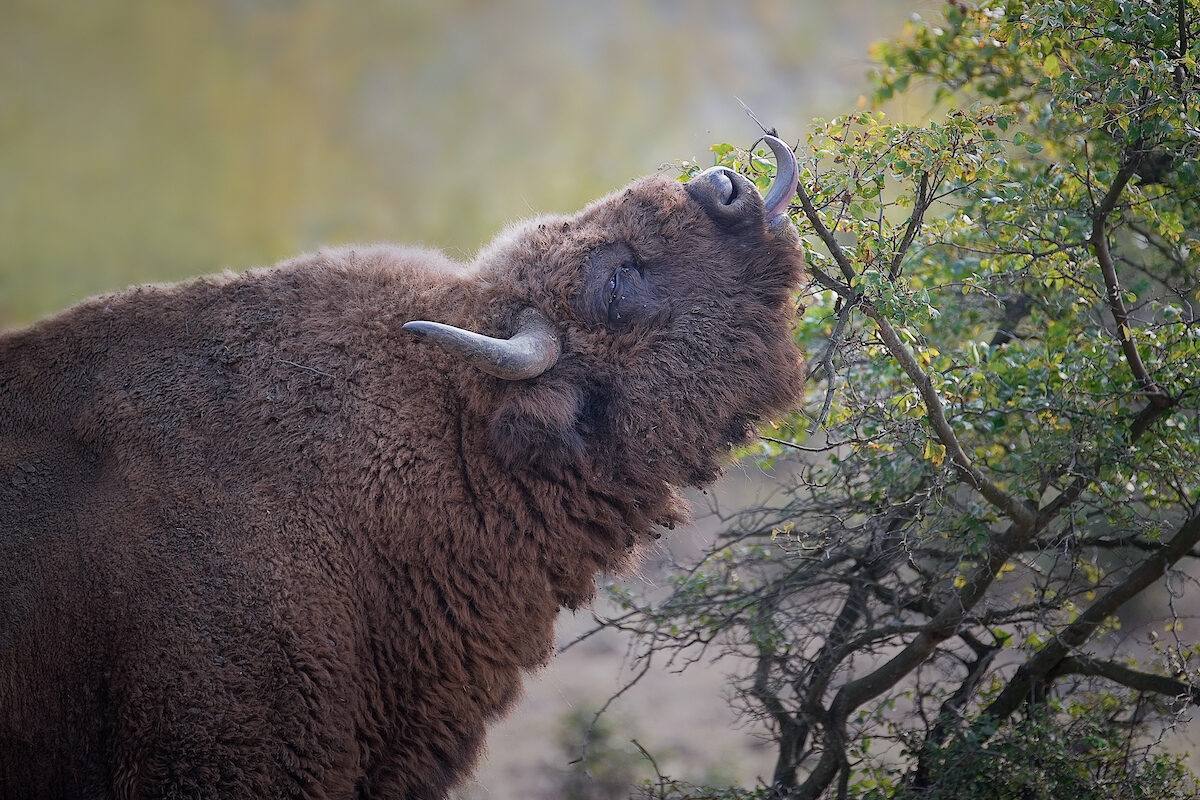
A huge appetite…
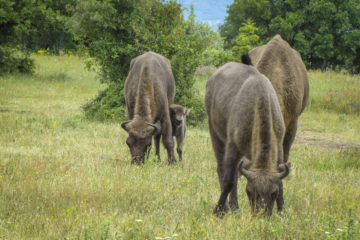
The European bison, Europe’s largest land animal, has an appetite to match its size – an adult male can consume an average of 32 kg of food every day in the summer. Being a ruminant (a herbivorous mammal that can acquire nutrients from plant-based food by fermenting it in its stomach), it can digest a wide range of plant-based food, including lignin, a complex organic polymer that, together with cellulose, forms the chief constituent of wood. This means it can digest bark, a specific adaptation of the animal to living in forested landscapes.
The diet of the European bison varies widely with the season. In spring it feeds mostly on young trees and shrubs, preferring willow, hornbeam and aspen. In the summer it consumes mostly grasses, shoots and young leaves. In winter, the consumption of shoots, seeds and bark increases significantly, with bison preferring the bark of hornbeam, ash and willow.
…and a huge impact
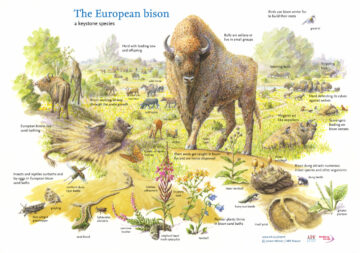
The European bison is a keystone species since it plays a distinct ecological role in shaping the landscape it inhabits. In addition to consuming great quantities of grasses and feeding on shrubs, bison influence the vegetation by de-barking trees, breaking open dense undergrowth (simply by walking right through it) and creating bare soil patches (by wallowing), which allows pioneer plants to move in. In addition, bison disperse nutrients (dung) and seeds across their territory (they scatter over 200 species of plants, which helps to increase floral biodiversity and supports pollinators). Breeding birds use bison winter fur as nesting material, and magpies follow the bison herd to pick off ticks and other parasites. According to Poelarends et al. (2012), nearly 600 invertebrate and vertebrate animals benefit from the presence of bison.
By consuming tree bark and creating open areas within forests, bison also act as natural “firefighters”, preventing damaging wildfires from spreading widely across the landscape.
Record-breaking reintroduction
Rewilding Europe and WWF Romania have been reintroducing European bison into the Southern Carpathians rewilding area in Romania since 2014. Today, the largest population of bison in Romania – numbering between 63 and 67 animals – is located here. The aim is to create a viable population that breeds in the wild and supports a thriving wild nature and nature-based economy, with the latter providing growing economic opportunities for local communities.
It has been established that the preferred habitat of European bison is a mosaic landscape of grassland and forest, which is the habitat the animals enjoy in the Southern Carpathians. Of the free-ranging populations of European bison reintroduced into forest habitats, more than half have expanded their range into open grassland.
Adapting to the wild
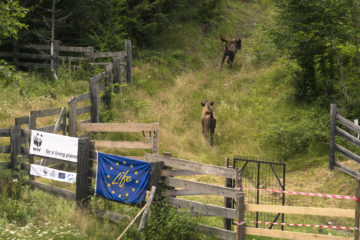
All bison reintroduced into the Southern Carpathians go through a period of acclimatisation, which allows them to adjust to their new environment and climate before being released. Some animals regain their survival instincts more slowly than others, depending on the frequency of their interaction with humans and the feeding habits acquired in their former homes.
European bison, in common with many other species, depend on natural salt deposits for the minerals they need for digestion. It takes time for the bison to find such deposits in the wild after they have been released, so bison rangers place mineralised and vitaminised salt in places frequented by the animals.
“After their first year of freedom we see how the bison become increasingly independent,” says bison ranger Matei Miculescu. “In terms of their feeding, it is really rewarding to see which types of trees and habitat are preferred and in which season. But we are happiest when the animals run away from us, because this means they have become truly wild.”
Feeding in exceptional conditions
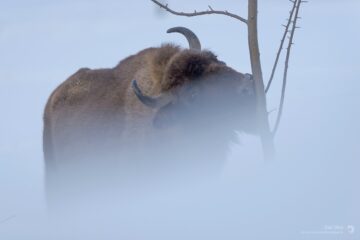
Bison specialists such as Dr. Rafał Kowalczyk, co-author of a recent assessment that removed bison from the list of vulnerable species and a member of the IUCN SSC Bison Specialist Group, stress the need for protected areas that provide a diversity of habitats for the animals – a mix of forests and grasslands that can offer the bison the required range of food and territory. This is what they have in the Southern Carpathians.
In extreme conditions, additional feeding is sometimes necessary to keep reintroduced bison away from cultivated land. Bison in the wild are typically well-adapted to harsh weather, but severe winters can still pose a threat to the most fragile or recently reintroduced animals. Animals that have been born and kept in captivity can be inexperienced at fending for themselves until they fully acclimatise.
Bison rangers track herd movements using GPS collars and monitor their health – if there are animals who appear weak they intervene and supply extra food. Hay is bought from local communities, while some locals, understanding and following ancient traditions, also leave orchards with old trees for the benefit of wild animals.
“The reserves of hay and vitamins are transported near the rewilding area for easy access in case of need,” explains Florin Hălăștăuan, who coordinates the rangers. “From here the rangers distribute them to the places most frequented by the bison to ensure they survive the winter.”
Living with gentle giants
European bison are wild animals. Like other wild animals – such as bears, wolves and lynx – they don’t recognise the rules and boundaries imposed by humans. In order to maintain a harmonious relationship between bison and local communities, we employ a range of proactive measures. These include feeding the animals in harsh winters, installing electric fences, using virtual fences that signal the presence of bison in high-risk areas by SMS, intervention groups to move the animals away in difficult situations, and tranquillizing and relocating individuals in extreme situations.
Providing members of the local community – from farmers to children to the local authorities – with accurate and useful information is important to maintain the right level of respect between people and bison.
Together we can make sure that European bison have the necessary conditions to adapt and thrive in the environment that was so familiar to them 200 years ago.
Want to know more?
